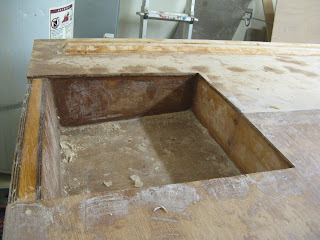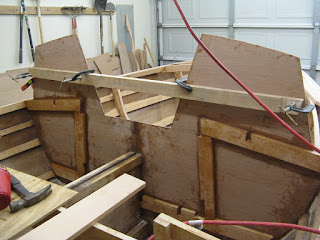The frames for the cabin bunks have been made. Here is the fore-side of the bulkhead with some frame members added. I made the top piece out of white oak, since I figured I'd be kicking it a lot climbing in and out of the cabin.

All of the bunk frame pieces are screwed and/or glued into notches in the hull frames. They will strengthen up the structure of the hull as well as provide a flat surface to sleep on in the coffin-sized cabin. I still need to add a few more pieces around the centerplate trunk. I'm going to wait to do that until after the cabin framing is done and I'm ready to install the mast compression posts.

The bunk plywood is a strange shape that is impossible to measure without a pattern. This is my pattern made from scrap cardboard.

And here are the resulting bunk plywood pieces made using the cardboard pattern. The two plywood pieces are slightly different, since the boat isn't perfectly symmetrical. Good thing I checked that before I cut out both of them. This plywood is going to be removable (not glued down), since I want to be able to check the area underneath for debris or rot and also use that space for storage or flotation foam.

Also, there are some removable plywood floors inside the cabin on either side of the centerplate trunk.

I was curious if I had enough plywood, so I cut out a lot of the plywood pieces I will be needing later. Here are all the rudder pieces cutout and waiting to be glued together. The rudder is a hinging "kick-up" type.

Also I cut out the aft, side, and fore deck pieces as well as the cockpit sole (floor). All of these pieces will eventually be glued and nailed down, but they are not attached to the hull yet in these pictures. Yes, even the cockpit sole will be glued down, but with a few round waterproof access ports to inspect the bilge underneath. (Remember, I'm modifying the design to make a water-tight cockpit).



Finally I got a lucky break ... the side deck plywood pieces were JUST narrow enough to loft onto one sheet of plywood, creating very little waste. I didn't plan for that when modifying the design and widening them, but fortunately I didn't make them a half an inch wider.
Also, I faired the tops of all the deck frames to the proper camber, as you can kinda see in this pic.

I figure I need two more sheets of plywood to finish the deck and make the cabin. That purchase can wait a week or two though. Next I'm going to clean up, sand, and paint the bilge, since that will be easier to do before the decks are installed. This doesn't seem like the most fun task of boat building, but it's gotta be done.
 The cabin deck frame members are glued and screwed to the cabin carlines. The front frame member is a bit tricky, because it has to match the curve of the cabin deck and the curve of the windscreen. To accomplish this, the front frame member is cut out with a slightly larger curve than the others and installed at an angle. All of the frame members were roughly cut, then installed on the boat. Then they are trimmed to shape. So the lumber cutting didn't require a lot of precision and isn't as complicated as it looks.
The cabin deck frame members are glued and screwed to the cabin carlines. The front frame member is a bit tricky, because it has to match the curve of the cabin deck and the curve of the windscreen. To accomplish this, the front frame member is cut out with a slightly larger curve than the others and installed at an angle. All of the frame members were roughly cut, then installed on the boat. Then they are trimmed to shape. So the lumber cutting didn't require a lot of precision and isn't as complicated as it looks.


















































